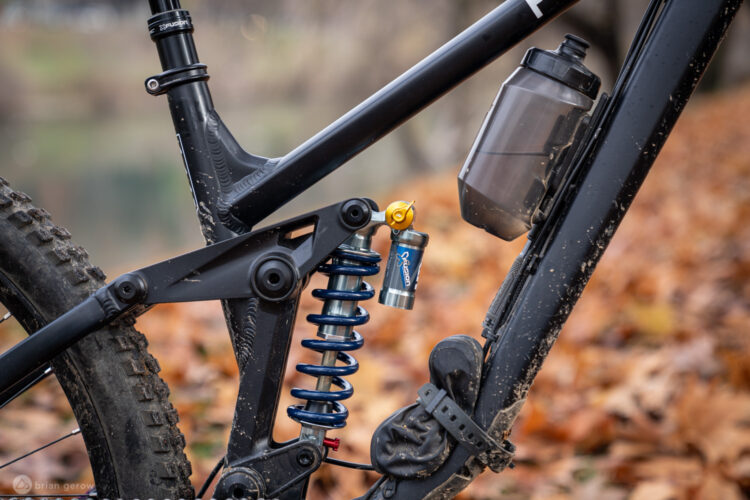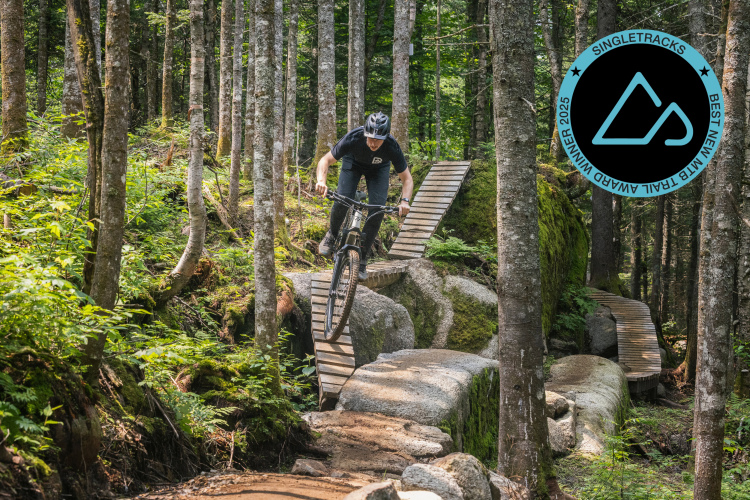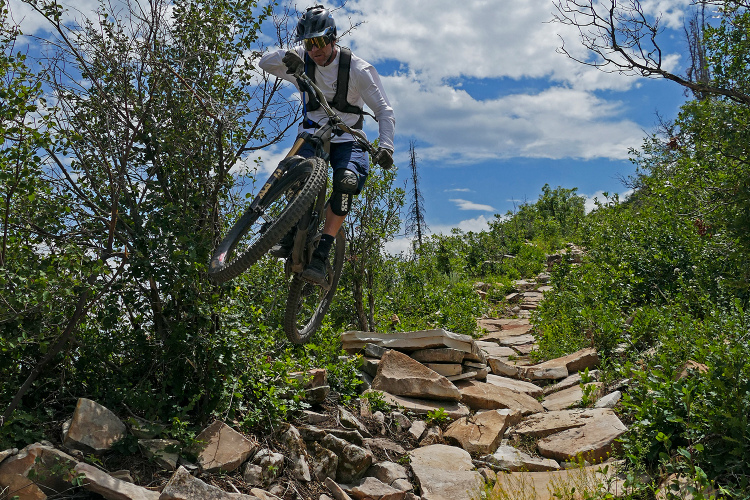
The engineers at X-Fusion have been designing mountain bike suspension since 1999, and their most recent gravity gear is being tested by the likes of Brian Lopes to make sure it’s up to snuff. I’ve been enjoying the H3C RCP coil shock over the past few months, and I’m stoked to share some in-depth impressions.
H3C RCP shocks come in metric or trunnion sizes, including 185/55(50), 205/65(60), 210/55(50), and 230/65(60)mm. If it fits your bike, you can get this squisher for $399, half the price of a lot of the competition. I tested the 205/65 trunnion model mounted on a Privateer 161 frame, a bike with a 161mm rear axle path and 170mm fork.
Regarding the surprising price, X-Fusion engineer, Mike Davis said that “[the] sharing of parts is a good portion of how we were able to keep cost down. The major reason for the price is the engineering itself. With the engineers having close ties to the production department, they are more in touch with machine times and the related costs of manufacturing. By streamlining the design and designing around easy to perform machine operations, they were able to cut a large chunk of cost out.”

Springs are available from 200 to 600lb/in at 50lb increments and the X-Fusion spring calculator makes an attempt at dialing in the correct spring rate for a given bike and rider weight. Unfortunately I didn’t find the spring calculator’s suggestions very useful or accurate. When I enter my riding weight and bike details it suggests a 500lb. spring to achieve 20% sag, a 400lb spring for 25%, 300lb for 30%, and a 250lb spring to achieve a 35% static-sag measurement.
I ended up feeling best on a 450lb spring, though I haven’t tried the 500lb option. Spring calculation across a variety of riding styles and suspension progression ratios is no easy task, and I don’t fault X-Fusion for the inaccurate calculation software. Most of them are ballpark at best, and typically more confusing than this one. Finding the right spring for your bike can take time, and it’s always helpful to check with the frame manufacturer or to go to a bike shop and test a few different springs before buying if possible. If your riding style is on the loose and aggressive side, you might want to consider starting with less sag to achieve maximum support when you need it most.
The H3C RCP “enduro” coil is differentiated from the brand’s H3C HLR “DH” shock by its three position compression switch for climbing and lack of high-speed compression adjustment that’s available on the downhill-focused model. Opposite the gold three-position lever, there is a low-speed compression dial with sixteen clicks of adjustment and a low-speed rebound knob at the base with roughly ten clicks of return adjustment. Both levers could use some work in the “clicks” department, as it’s quite difficult to feel or hear when you have passed one. Adjustments with the compression knob are a little more clear than those from the rebound, though both could use a more defined feel or sound.

Coupled with a 400lb. spring, the H3C shock weighs 753g. A single 400lb. X-Fusion spring weighs 410g and the 450lb. spring weighs 425g. The same size Formula MOD that we recently tested weighs 786g with the same size spring and mounting hardware. While weight isn’t the top concern for a coil-worthy bike, we know it is somewhere on the list of considerations. Davis added that “as far as light [weight] goes, we used a narrower body based on the current O2 main piston, instead of the larger vector piston.”
Setting up the H3C went similarly to most coil shocks. I started with the lightest spring preload possible to ensure maximum traction, and dialed the compression and rebound open to the middle settings.

Most coil shocks perform differently depending on the spring rate that’s installed, and this one is no different, so I’ll share my experience with both the 400 and the 450lb. springs.
Starting off on the 450lb. spring, I have greatly enjoyed the amount of mid-stroke support and bottom-out ramp that this shock provides. The Privateer 161 doesn’t have the highest leverage ratio, so the bulk support needs to come from the shock’s spring and hydraulic circuits. With this stiffer spring, the rear end remains higher in its travel through successive impacts, and the shock doesn’t become overwhelmed. I was able to keep the rebound closed by about four clicks, and the compression similarly four clicks from fully open, allowing the spring to move fairly freely.
The heavier spring also negates the need for the H3C shock’s three-position climb switch, since there is plenty of support from the spring while pedaling. With the switch fully open the bike maintains solid climbing traction while not bobbing around too much. I did flip it closed on some longer paved climbs, though I quit that practice after the first time that I forgot to flip the compression switch open at the top of a descent. A tiny amount of suspension movement while pedaling is far less annoying than stopping mid descent to flip the switch. The suspension does still move with the switch closed, as it’s not a true lockout; it simply firms things up a bit.
I managed to bottom the shock out multiple times with both springs on some fun drop-to-flat hucks, though the 450lb. coiled-steel took a little more effort. The H3C bottom-out bumper does as good a job as any at smoothing and silencing the end of the stroke, and there’s virtually no noise associated with the last few millimeters. Coil lovers can rejoice in the fact that these modern steel-sprung shocks are far quieter than they were just five years ago. The spring also doesn’t clang as the shock snaps open between impacts, leaving it quieter than some air-sprung shocks that go gasping through the forest.

With the lighter 400lb spring, I have to crank the rebound almost all the way open to help ready the shock for its next impact without packing up and squatting the back of the bike. I also added about five clicks of low-speed compression from where it was set with the heavier spring. I don’t love the feel of using compression instead of a stiffer spring, but in this case, it makes for a workable setup that gives the bike a completely different ride character. It’s transformed into a trail-flattening sofa.
So why would someone want to use a softer spring? Well, it depends on how you ride, and what you want from your bike as a riding platform. The softer spring smooths the trail out significantly, reducing fatigue and potentially increasing fun. The bike feels less active, as it floats like a boat over the trail vaguely rather than being actively pump-able through every compression and over every root. When you launch off a jump or drop into a mess of rocks it feels more like a smooth section of trail, provided you don’t bottom it out and the shock doesn’t pack up. The flip side of that is where a stiffer spring will send more trail feedback to the rider in rough sections, but it’s also easier to pump-through and loft-over those same obstacles, and it leaves you with a little “emergency travel” just in case.
Another reason to use a lighter spring is if you fall between two springs, and want to be able to dial in the shock to your exact taste using the compression circuit. The rebound knob on this shock is one of the most sensitive I have used to date. One click in either direction is noticeable, whereas two clicks on some shocks can be difficult to feel. The rebound range is fairly wide, and it definitely can be lightning-fast if you like, so riders who prefer a super smooth rear end can likely run a lighter spring with a little faster rebound to find their happy place. When we asked about return speed Davis said that “the shape on the rebound adjuster cam is aggressive in its curve, allowing for more total movement as well as more resolution between clicks.”
The low-speed compression adjuster is less sensitive between clicks, and folks who want to charge into everything will likely feel better on a stiffer spring to pair with the rebound circuit, instead of a lighter one with increased low-speed rebound. Once I found the exact support I wanted with the 450lb. spring the compression knob still had a lot of adjustment left that will be useful on different trails, or summer days in the bike park. This does depend considerably on your bike’s suspension platform, but with the heavier spring on the Privateer 161 with my body weight and riding style, the shock gives the bike a more spry and lively feel than it has with other coils.

It’s manner takes a little time to adjust to, but once the settings are dialed the H3C RCP feels fantastic. The shock offers ample support, and its settings are noticeable and useful. I would love to see an external high-speed compression adjustment on the next iteration so it could be tuned even further, but this relatively simple and light shock will have most riders stoked to go pedal just as it is.











4 Comments
Mar 25, 2021
Mar 20, 2021
Apr 13, 2021
Mar 25, 2021